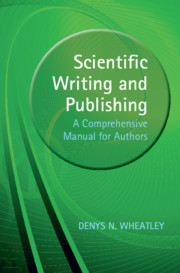Book contents
- Scientific Writing and Publishing
- Scientific Writing and Publishing
- Copyright page
- Contents
- Acknowledgements
- Introduction
- 1 General Features of a Scientific Paper
- 2 The Typical Scientific Paper
- 3 Results
- 4 Discussion
- 5 The Introduction
- 6 Materials and Methods
- 7 The Abstract
- 8 The ‘Smaller’ Sections That Complete a Paper
- 9 Figures and Tables
- 10 Presubmission
- 11 Submission of Manuscripts
- 12 Peer Review
- 13 The Last Stages of the Editorial Process
- 14 From Acceptance to Publication
- 15 Copyright
- 16 Ethics and Scientific Integrity
- 17 Epilogue
- Further Reading
- Index
1 - General Features of a Scientific Paper
Structure and Format
Published online by Cambridge University Press: 14 October 2021
- Scientific Writing and Publishing
- Scientific Writing and Publishing
- Copyright page
- Contents
- Acknowledgements
- Introduction
- 1 General Features of a Scientific Paper
- 2 The Typical Scientific Paper
- 3 Results
- 4 Discussion
- 5 The Introduction
- 6 Materials and Methods
- 7 The Abstract
- 8 The ‘Smaller’ Sections That Complete a Paper
- 9 Figures and Tables
- 10 Presubmission
- 11 Submission of Manuscripts
- 12 Peer Review
- 13 The Last Stages of the Editorial Process
- 14 From Acceptance to Publication
- 15 Copyright
- 16 Ethics and Scientific Integrity
- 17 Epilogue
- Further Reading
- Index
Summary
The chapter indicates our reasons for publishing, the framework of a communication, how to introduce the topic and put forward a hypotheses before considering each of the conventional sections of a paper. It also emphasizes that the sequence in how a paper is compiled section by section will not be the order given here.
Keywords
- Type
- Chapter
- Information
- Scientific Writing and PublishingA Comprehensive Manual for Authors, pp. 16 - 27Publisher: Cambridge University PressPrint publication year: 2021

